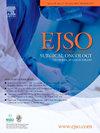Failure of early interval debulking surgery after standard neoadjuvant chemotherapy: May bevacizumab add something? A large retrospective study
IF 3.5
2区 医学
Q2 ONCOLOGY
引用次数: 0
Abstract
Introduction
Data are limited on the use of bevacizumab in neoadjuvant setting for High-Grade Serous ovarian Cancer (HGSC) patients. This study explores the effect of adding bevacizumab to standard neoadjuvant chemotherapy (NACT) following the failure of early Interval Debulking Surgery (eIDS).
Materials and methods
This monocentric study retrospectively enrolled FIGO stage IIIC-IV HGSC patients (2017–2021), persisting unresectable after three NACT cycles. Eligible patients had an ECOG performance status ≤2, were aged 40–75 years, and had no contraindications to bevacizumab administration. Patients were stratified whether they added bevacizumab from cycles 4 to 6 (CPB group) or not (CP group). The primary endpoint was the cytoreduction rate after six cycles (delayed IDS, dIDS).
Results
Overall, 58(23 %) patients received neoadjuvant bevacizumab(CPB), and 190 (77 %) did not (CP). Delayed IDS was performed in 117(47.6 %) patients (CPB:31–53.4 %; CP:86–45.8 %; p = 0.38), with complete gross resection rates of 83.9 % and 88.5 %, respectively (p = 0.72). Severe postoperative complications were comparable (CP: 8 %, CPB: 9.7 %, p = 0.069). Median overall survival (OS) for dIDS patients showed no significant difference (CPB: not reached, CP:38 months, p = 0.55), nor did progression-free survival (PFS; CPB:14 months, CP:12 months, p = 0.830). Conversely, among 130(52 %) patients persisting unresectable, bevacizumab significantly improved OS in the CPB group (not reached vs.18 months, p = 0.015), although PFS remained similar (CPB: 6 months, CP: 7 months, p = 0.741).
Conclusion
While adding bevacizumab to NACT does not seem to increase the dIDS rate, it significantly extends OS in unresectable patients. Its use may be a valuable option in selected cases after eIDS’ failure.
标准新辅助化疗后早期间期减脂手术失败:贝伐单抗是否有帮助?一项大型回顾性研究
关于贝伐单抗在高级别浆液性卵巢癌(HGSC)患者新辅助治疗中使用的数据有限。本研究探讨了在早期间隔减体积手术(eIDS)失败后,在标准新辅助化疗(NACT)中加入贝伐单抗的效果。材料和方法本单中心研究回顾性纳入FIGO IIIC-IV期HGSC患者(2017-2021),在三个NACT周期后持续不可切除。符合条件的患者ECOG表现状态≤2,年龄40-75岁,无贝伐单抗禁忌症。对患者进行分层,是否在第4至6个周期(CPB组)添加贝伐单抗(CP组)。主要终点是6个周期后的细胞减少率(延迟IDS, dIDS)。结果总体而言,58例(23%)患者接受了新辅助贝伐单抗(CPB)治疗,190例(77%)患者未接受新辅助贝伐单抗治疗(CP)。延迟IDS患者117例(47.6%)(CPB:31 - 53.4%;CP: 86 - 45.8 %;P = 0.38),总完全切除率分别为83.9%和88.5% (P = 0.72)。严重的术后并发症比较(CP: 8%, CPB: 9.7%, p = 0.069)。dIDS患者的中位总生存期(OS)无显著差异(CPB:未达到,CP:38个月,p = 0.55),无进展生存期(PFS;CPB:14个月,CP:12个月,p = 0.830)。相反,在130例(52%)持续不可切除的患者中,贝伐单抗显著改善了CPB组的OS(未达到18个月,p = 0.015),尽管PFS保持相似(CPB: 6个月,CP: 7个月,p = 0.741)。结论在NACT中加入贝伐单抗似乎不会增加dIDS的发生率,但它显著延长了不可切除患者的OS。在eIDS失败后的特定情况下,使用它可能是一个有价值的选择。
本文章由计算机程序翻译,如有差异,请以英文原文为准。
求助全文
约1分钟内获得全文
求助全文
来源期刊

Ejso
医学-外科
CiteScore
6.40
自引率
2.60%
发文量
1148
审稿时长
41 days
期刊介绍:
JSO - European Journal of Surgical Oncology ("the Journal of Cancer Surgery") is the Official Journal of the European Society of Surgical Oncology and BASO ~ the Association for Cancer Surgery.
The EJSO aims to advance surgical oncology research and practice through the publication of original research articles, review articles, editorials, debates and correspondence.
 求助内容:
求助内容: 应助结果提醒方式:
应助结果提醒方式:


